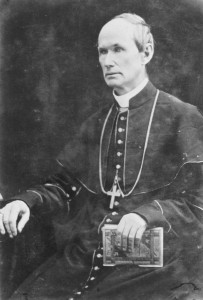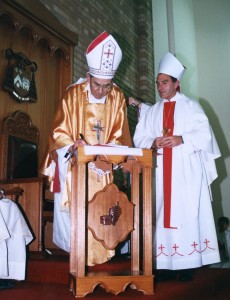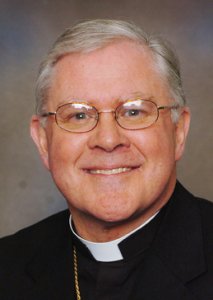History of the Archdiocese
A People in Time
To move into the future we should own our collective past. The God of Abraham, Isaac and Jacob walks with us, as he did with the disciples on the road to Emmaus and as he did with the faithful who established our local church of Canberra and Goulburn. The Good Shepherd now calls us into the third millennium. We are a pilgrim people; a people of memory and a people of hope. Something of the past is documented, most of it passes in the unrecorded efforts and aspirations of ordinary people. Our individual story colours the bigger story which each generation renews. In The Catholic Weekly of Easter 1981, historian Father Edmund Campion wrote:
“History is what makes us Catholics. For as Catholic Christians we lay claim to a tradition that links us to the Risen Christ. While others define themselves by reference to the Bible, we define ourselves by reference to history. Our history is salvation history and we are part of it.”
Unity in Diversity
The Archdiocese of Canberra and Goulburn evolved from the Diocese of Goulburn, which was itself created on 17 November 1862. It covered the area between the Lachlan and Murray rivers. The first bishop, Patrick Bonaventure Geoghegan, died before taking up his appointment. He was succeeded by
evolved from the Diocese of Goulburn, which was itself created on 17 November 1862. It covered the area between the Lachlan and Murray rivers. The first bishop, Patrick Bonaventure Geoghegan, died before taking up his appointment. He was succeeded by
Bishop William Lanigan who arrived in the diocese on Pentecost Sunday, 9 June 1867. There were seven parishes, served by ten priests and one congregation of religious, the Sisters of Mercy at Goulburn.These were turbulent times. In 1866 ten bushrangers were hanged and 13 shot in and around Goulburn. Bishop Lanigan saw the diocese through a period of rapid population growth. There has always been a very high concentration of Catholics in the Monaro and on the South West Slopes. Boorowa was at one time referred to as the ‘Tipperary of Australia’ and in an 1861 census Binalong was 75% Catholic. Caroline Chisholm recognised this and brought many girls and families to her depots at Goulburn and Yass in the hope of finding employment and perhaps marriage. Lanigan’s decision to establish an independent Catholic school system, in response to the 1880 Parkes’ Public Instruction Act, saw a marked increase in the number of schools and religious in the diocese. Parish based education has been a characteristic of Australian Catholic life. The former St Patrick’s College, Goulburn, laid claim to being one of the oldest Catholic boarding schools in Australia.
The Archdiocese of Canberra and Goulburn was created on 11 February 1948. The archdiocese is one of 11 dioceses in NSW. It covers an area of 88,000 square kilometres, an area 30% bigger than the State of Tasmania. There are 59 parishes and 165,000 Catholics within its borders. From the extensive coastline, to the Snowy Mountains, to the rolling hills and flat plains out west, the geographical diversity of our archdiocese reflects the church’s self-understanding of ‘unity in diversity’.
The Early Days
The origins of the archdiocese can be traced to 1838 when a mission centre was established at Yass. Until 1841 the Yass mission included Port Phillip, later Melbourne. Mission centres were also established at Goulburn (1840) and Queanbeyan (1842). The priests of these early missions rode many thousands of kilometres under the most trying conditions. In 1839 Bishop John Bede Polding made the first of three missionary journeys into what is now the Canberra and Goulburn Archdiocese. Polding had a particular sensitivity to the plight of convicts and Aborigines.
can be traced to 1838 when a mission centre was established at Yass. Until 1841 the Yass mission included Port Phillip, later Melbourne. Mission centres were also established at Goulburn (1840) and Queanbeyan (1842). The priests of these early missions rode many thousands of kilometres under the most trying conditions. In 1839 Bishop John Bede Polding made the first of three missionary journeys into what is now the Canberra and Goulburn Archdiocese. Polding had a particular sensitivity to the plight of convicts and Aborigines.
The Diocese of Goulburn Established
Ss. Peter and Paul’s, the former cathedral of the archdiocese, was erected by Lanigan and celebrated its centenary in 1987. After 33 years of devoted service, Lanigan died in 1900.
Consolidation
Lanigan’s successor, Bishop John Gallagher (1900-1923), is remembered as a classics scholar who consolidated the growth of Catholic education in the archdiocese. In 1917 the south west portion of the archdiocese became Wagga Wagga Diocese. In that same year the Monaro and far south coast parishes were ceded to Goulburn from Sydney. Meanwhile the shadow of death claimed many thousands of young Australians on distant battle-fields in the Great War of 1914-1918. Bishop Gallagher was succeeded by Bishop John Barry (1924-1928).
Canberra’s Beginnings

The place name Canberra is derived from an Aboriginal word meaning ‘meeting place’, a rather appropriate name for the seat of federal parliament. In 1928 Canberra was established as a parish. Monsignor Patrick M. Haydon was appointed the first parish priest. In that same year St. Christopher’s School, Manuka, was opened under the care of the Good Samaritan Sisters. For the next ten years the school also served as a place where Mass was celebrated. The renovated school buildings and convent now serve as church offices.
On 8 May 1938 the foundation stone of St. Christopher’s Church, now Cathedral, was laid by Archbishop Gilroy and in June 1939 the church was solemnly blessed and opened by the Apostolic Delegate, Archbishop Panico.
Bishop Barry was succeeded by Bishop Terence Bernard McGuire (1938-1953). Australians were once more called to arms in the Second World War, the character of which necessitated a marked change in our nation’s perception of its position in world and regional affairs.
Church and Society on the Move
Post-war migration gave a cosmopolitan character to the Australian population. Archbishop McGuire pushed for an Australian clergy while acknowledging the great debt owed to the predominantly Irish clergy who had come to Australia.
The 1940s and 1950s were vibrant times with thousands of Catholic youth meeting under the banners of the Children of Mary, CYM, CYO and YCW. Likewise, the Holy Name Society and the Catholic Women’s League counted their membership in the thousands. The Cathedral Chimes was a source of news and information across the archdiocese during these years, as is Catholic Voice today. The demands of education and the reliance upon a rural economy saw the establishment of St. Michael’s Agricultural College at Inveralochy, near Goulburn. It was a time of increased devotion to Mary, Mother of God. It was also during this time that there began a long period of conservative federal government. The split in the Labor Party in no small measure assisted this development and soured relations between some dioceses
In 1953 Archbishop McGuire was succeeded by the renowned Australian historian, Eris Michael O’Brien. His episcopate (1953-1966) was characterised by the expansion of Canberra into a major city. Within the church and wider society there was an air of confidence and excitement. Australia was on the move. There was rapid population growth in the Canberra-Queanbeyan and Snowy Mountains areas. There was an increasing movement from country to town and city. Government funding for private schools had become a reality after a long and bitter struggle which culminated in the Goulburn Catholic Schools’ strike of 1962. It was the time of the Second Vatican Council, a time of plenty in vocations to the priesthood and religious life. In 1960 the archdiocese had 35 seminarians in training for the priesthood, in 1986 there were 15 and 10 years later only four. However, since 1960 the population of the archdiocese has more than doubled and that of Canberra has increased more than sixfold.
In 1967 Archbishop O’Brien was succeeded by Thomas Vincent Cahill. Archbishop Cahill (1967-1978) worked hard to avoid extremism in the aftermath of the Second Vatican Council (1963-1965) and in the midst of much social and political change. Personal and institutional authority was challenged. Many drifted from the church which they considered too rigid in an age emphasising individual freedom. The church’s liturgy or public worship changed rather dramatically, in form if not always in spirit. The decreasing numbers of priests and religious saw lay people, by default and, or in accordance with a renewed understanding of a call to ministry through baptism, increasingly emerge in leadership roles, especially in Catholic schools and various formation groups. Dialogue with other Christians, non-Christians and others of good will saw justice issues affirmed as being constitutive of the gospel
Archbishop Edward Bede Clancy, later to become the Cardinal Archbishop of Sydney, followed Archbishop Cahill in 1979 and he, in turn, was followed in August 1983 by Archbishop Francis Patrick Carroll.

Three years after his arrival in Canberra, Archbishop Carroll was to welcome Pope John Paul II at the start of his Australian visit. A decade later the pope was to return to Australia for the memorable beatification of Mary MacKillop -‘woman for our times.’
The greed of the 1980s was to be followed by the economic rationalism, high unemployment and ‘user pays’ mentality of the 1990s. The scourge of AIDS, the call for legalised euthanasia, the breakdown in marriage and family life, the lands rights issue, the rural recession, the call for a republic and rapid advances in information technology have caused not a little disquiet in our society, as has the scandal of child sexual abuse by priests and religious. Clearly, both our society and our church are in need of ongoing reform and reconciliation.
Consultation and Co-responsibility
Recognising that we must ‘discern the signs of the times’ and that everyone has a contribution to make, Archbishop Carroll worked hard to build diocesan unity. This was not made any easier by the fact that the archdiocese consists of a “widely incongruous social mix of Federal Capital and traditional rural towns”. Archbishop Carroll’s establishment of the Diocesan Pastoral Council in 1985 reflected his desire for diocesan unity. So too his announcement on Pentecost Sunday 1987 that this archdiocese was to hold a Diocesan Synod in 1989: the first in Australia since the Second Vatican Council and the first in this archdiocese since 1949.
In calling for a synod with the theme of ‘Coming Home in Christ’ – for it is in Christ that we are most at home in our search for the answers to life questions – the archbishop asked “for a conscious commitment to a program of prayer, reflection, dialogue, consultation and planning.” He maintained that the synod was a means “to listen to what the Spirit is saying to us today. From this will surely come clearer planning and direction.”
An immediate practical outcome of the Synod was the formation of a Pastoral Planning Committee of laity, clergy and religious personnel, to act as a consultative body and to implement Synod resolutions. It represented a major landmark in efforts of the Diocesan Church to answer the challenges of the Second Vatican Council.
The progress of the archdiocese over the past half century reached a new landmark late in 2000 when Archbishop Carroll called the Archdiocese to undertake a second Synod, to journey together in a process culminating in a formal meeting in May 2004.
In his pastoral letter to the people of the Archdiocese for Lent 2001, he wrote, “We are speaking to a church that is weary and often discouraged. Many of its members are disillusioned and apathetic. It is speaking in a world that is tense with anxiety about its future, fearful of terrorism and war and desperately in need of a message of hope. In listening and responding we all have a part to play. The Synod seeks to be all inclusive and invites the active participation of all members of our Catholic Church – lay, clergy, religious, married and single, young and old, church-going and non-church going. There is a place for all. It will seek positive interaction with Christians of other traditions and dialogue with the wider Australian society and culture.”
A Time of Great Opportunity
Archbishop Carroll saw the new millennium as a time of great opportunity. Heeding the call of Pope John Paul II, at the dawn of this new age, in his encyclical letter “Novo Millenio Ineunte” and attempting to apply the principles set out in the Pope’s address to the people of Oceania in 2001, Archbishop Carroll issued the challenging call to “Launch out into the Deep”. It was a sincere attempt to address some of the more difficult questions confronting the Church today.
Speaking in St Christopher’s Cathedral at a Mass at which he promulgated his official findings from the 2004 Synod, Archbishop Carroll said he had accepted practically all the Synod recommendations, most fully, some in principle, in part, or with modifications.
Among the recommendations Archbishop Carroll accepted were the formation of a Commission for Women in the Archdiocese, a commitment to resource and support the Catholic Youth Ministry team for the next five years, the embracing of the concept of Partnership in Ministry, encouraging parishes to implement family-based sacramental programs, and calling on parishes to consider the employment of pastoral associates possibly in conjunction with neighbouring parishes.
 So to 2006, which was marked by the succession of Archbishop Mark Benedict Coleridge, born and bred in Melbourne, to the see of Canberra and Goulburn, and the retirement of Archbishop Carroll after 23 years service to the archdiocese and a lifetime to the Catholic Church in Australia.
So to 2006, which was marked by the succession of Archbishop Mark Benedict Coleridge, born and bred in Melbourne, to the see of Canberra and Goulburn, and the retirement of Archbishop Carroll after 23 years service to the archdiocese and a lifetime to the Catholic Church in Australia.
Politicians from both sides of parliament paid tribute to Archbishop Carroll, one describing him as “a figure of distinction in this city and this nation”. At a tribute dinner, Labor leader Mr Kim Beazley said Archbishop Carroll was “not just a man of God, but a man for God, who has spoken for the mainstream of the Catholic Church in Australia in the heart of the nation’s political establishment”. Health Minister Mr Tony Abbott said it was a great tribute to Archbishop Carroll’s standing that so many distinguished people had gathered for the dinner. Leaders from within the Catholic Church, from other Christian churches and from the community at large paid handsome tribute to him through the pages of Catholic Voice.
A Servant of the Entire Community
Archbishop Coleridge, in his first statements in Canberra, spoke of his desire to be a man who served the entire community, not only Catholics. He emphasised that he saw being active in the public domain as one of his prime responsibilities. “It’s tempting to see a Catholic bishop as someone who just does his little churchy thing with his church flock,” he said. “The Catholic understanding is that the Church does have to engage the public domain in a distinctive way born of the Gospels.”
It has been a long journey since Fr John Therry gathered the oppressed convict servants together to celebrate the Sacred Mysteries. He ranged over a vast and unfamiliar landscape. Their descendants in the Catholic faith continue to face the challenges of that vast landscape of city and country, surf and mountains. The journey goes on yet.
Archbishop Coleridge served in Canberra and Goulburn until his transfer on 2 April, 2012, to the Metropolitan See of Brisbane.
A new Archbishop

Bishop Christopher Prowse, of Sale, was appointed by Pope Francis on 12 September, 2013, as the Archdiocese’s seventh Archbishop. He was installed at St Christopher’s Cathedral in Canberra on Tuesday, 19 November, 2013.
Past Bishops
Archbishop Mark
 Coleridge (2006-2013)
Coleridge (2006-2013)
Archbishop Mark Coleridge was born in Melbourne on September 25, 1948, the third of five children. He was educated in South Australia and Victoria, and completed an Arts degree at Melbourne University. From 1969 to 1974 he studied for the priesthood at Corpus Christi College, and was ordained on May 18, 1974 at St Patrick’s Cathedral in Melbourne.
In 2001 he was ordained an Auxiliary Bishop for Melbourne, and in 2006 was appointed as the sixth Archbishop of Canberra and Goulburn, following the retirement of Archbishop Francis Carroll. On April 2, 2012, he was transferred to the Metropolitan See of Brisbane.
Bishop Emeritus Pat Power (1986-2012)

Bishop Pat Power was born in Cooma, New South Wales on February 11, 1942. He grew up in Queanbeyan, completed his primary schooling at St Christopher’s School, Canberra, and was a foundation student in 1954 of St Edmund’s College.
After leaving school, he undertook seven years of training for the priesthood at St Columba’s College, Springwood and St Patrick’s College, Manly. He was ordained in Queanbeyan on July 17, 1965.
On April 18, 1986, he was ordained Auxiliary Bishop by Archbishop Carroll at St Christopher’s Cathedral. He served the Archdiocese of Canberra and Goulburn in the role for more than 25 years, before retiring on June 7, 2012.
Archbishop Emeritus Francis Carroll (1982-2006)

Archbishop Francis Carroll was born in Ganmain, New South Wales on September 9, 1930 and was educated for the priesthood at Manly College. He was ordained on July 27, 1954, and after several parish appointments he proceeded to undertake studies in Canon Law from 1961 to 1964 in Rome.
He became coadjutor Bishop of Wagga Wagga on September 5, 1967, succeeding to the Diocese there on February 24, 1968. He was transferred as Archbishop of Canberra and Goulburn, with his installation taking place on August 31, 1983 at St Christopher’s Cathedral.
Archbishop Carroll was elected President of the Australian Catholic Bishops’ Conference in 2000. He retired from his role as Archbishop of Canberra and Goulburn in 2006 and was replaced by Archbishop Mark Coleridge.
